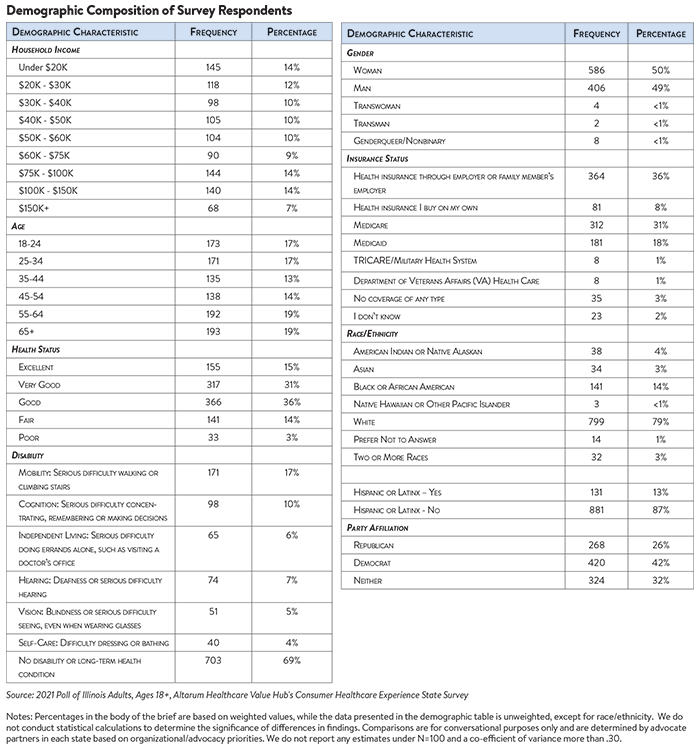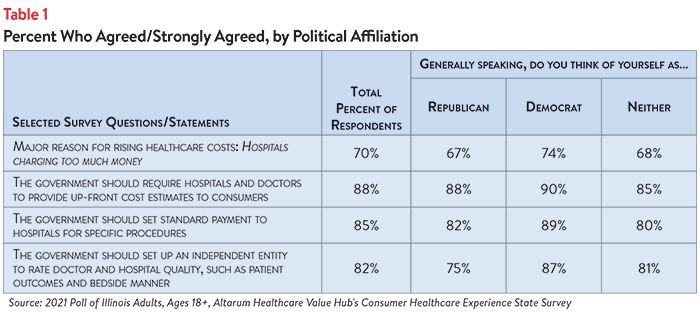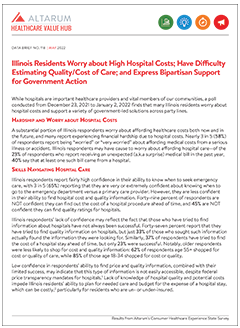Illinois Residents Worry about High Hospital Costs; Have Difficulty Estimating Quality/Cost of Care; and Express Bipartisan Support for Government Action
While hospitals are important healthcare providers and vital members of our communities, a poll conducted from December 23, 2021 to January 2, 2022 finds that many Illinois residents worry about hospital costs and support a variety of government-led solutions across party lines.
Hardship and Worry about Hospital Costs
A substantial portion of Illinois respondents worry about affording healthcare costs both now and in the future, and many report experiencing financial hardship due to hospital costs. Nearly 3 in 5 (58%) of respondents report being “worried” or “very worried” about affording medical costs from a serious illness or accident. Illinois respondents may have cause to worry about affording hospital care—of the 23% of respondents who report receiving an unexpected (a.k.a surprise) medical bill in the past year, 40% say that at least one such bill came from a hospital.
Skills Navigating Hospital Care
Illinois respondents report fairly high confidence in their ability to know when to seek emergency care, with 3 in 5 (65%) reporting that they are very or extremely confident about knowing when to go to the emergency department versus a primary care provider. However, they are less confident in their ability to find hospital cost and quality information. Forty-nine percent of respondents are NOT confident they can find out the cost of a hospital procedure ahead of time, and 45% are NOT confident they can find quality ratings for hospitals.
Illinois respondents’ lack of confidence may reflect the fact that those who have tried to find information about hospitals have not always been successful. Forty-seven percent report that they have tried to find quality information on hospitals, but just 33% of those who sought such information actually found the information they were looking for. Similarly, 37% of respondents have tried to find the cost of a hospital stay ahead of time, but only 23% were successful. Notably, older respondents were less likely to shop for cost and quality information: 62% of respondents age 55+ shopped for cost or quality of care, while 85% of those age 18-34 shopped for cost or quality.
Low confidence in respondents’ ability to find price and quality information, combined with their limited success, may indicate that this type of information is not easily accessible, despite federal price transparency mandates for hospitals.1 Lack of knowledge of hospital quality and potential costs impede Illinois residents’ ability to plan for needed care and budget for the expense of a hospital stay, which can be costly,2 particularly for residents who are un- or under-insured.
Support for “Fixes” across Party Lines
Hospitals, along with drug manufacturers and insurance companies, are viewed as a primary contributor to high healthcare costs. When given more than 20 options, those that Illinois respondents most frequently cited as being a “major reason” for high healthcare costs were:
- 70%–Hospitals charging too much money
- 69%–Drug companies charging too much money
- 65%–Insurance companies charging too much money
- 57%–Large hospitals or doctor groups using their influence to get higher payments from insurance companies
Illinois respondents strongly endorse a number of hospital-related strategies, including:
- 88%–Require hospitals and doctors to provide up-front cost estimates to consumers3
- 85%–Set standard payment to hospitals for specific procedures
- 82%–Set up an independent entity to rate doctor and hospital quality, such as patient outcomes and bedside manner
- 63%–Pay doctors and hospitals a fixed monthly fee per patient, instead of payment for each service
What’s even more interesting is the level of support for some of these strategies across party lines (see Table 1).
Conclusion
The findings from this poll suggest that Illinois respondents are somewhat motivated when it comes to searching for hospital cost and quality information to help inform purchasing decisions and plan for a future medical expense. However, cost and quality information is difficult for Illinois respondents to find, despite recent action at the federal level to make hospital prices more transparent.4
It is not surprising that Illinois respondents express strong support for government-led solutions to make price and quality information more readily accessible and to help patients navigate hospital care. Many of the solutions respondents’ support would take the burden of research and guesswork off of consumers’ shoulders, by standardizing payments for specific hospital procedures, requiring hospitals and doctors to provide consumers cost estimates for certain procedures and establishing an entity to conduct independent quality reviews. Policymakers should investigate the evidence on these and other policy options in order to respond to Illinois respondents’ bipartisan call for government action.
Notes
1. As of Jan. 1, 2021, the Centers for Medicare and Medicaid Services (CMS) requires hospitals to make public a machine-readable file containing a list of standard charges for all items and services provided by the hospital, as well as a consumer-friendly display of at least 300 shoppable services that a patient can schedule in advance. For more information, see: https://www.cms.gov/hospital-price-transparency/hospitals
2. According to Health Forum, an affiliate of the American Hospital Association, hospital adjusted expenses per inpatient day in Illinois were $2,754 in 2019–just below the national average. See: State Health Facts Data: Hospital Adjusted Expenses per Inpatient Day, Kaiser Family Foundation. Accessed Feb. 22, 2021.
3. Ibid.
4. This survey was conducted after the Centers for Medicare and Medicaid Services’ rule requiring hospitals to publicly display all standard charges for all items and services, as well as shoppable services, in a consumer-friendly format went into effect. While survey respondents may be reflecting on their experiences before the rule went into effect, the well-documented low compliance from large hospitals indicates that the rule has yet to demonstrate the desired effect. See: Kurani, Nisha, et al., Early Results from Federal Price Transparency Rule Show Difficulty in Estimating the Cost of Care, Kaiser Family Foundation (April 9, 2021). See also: Henderson, Morgan, and Morgane C. Mouslim, “Low Compliance from Big Hospitals on CMS’s Hospital Price Transparency Rule,” Health Affairs Forefront (March 16, 2021).
Methodology
Altarum’s Consumer Healthcare Experience State Survey (CHESS) is designed to elicit respondents’ unbiased views on a wide range of health system issues, including confidence using the health system, financial burden and views on fixes that might be needed.
The survey used a web panel from Dynata with a demographically balanced sample of approximately 1,000 respondents who live in Illinois. The survey was conducted in English or Spanish and restricted to adults ages 18 and older. Respondents who finished the survey in less than half the median time were excluded from the final sample, leaving 1,012 cases for analysis. After those exclusions, the demographic composition of respondents was as follows, although not all demographic information has complete response rates:









